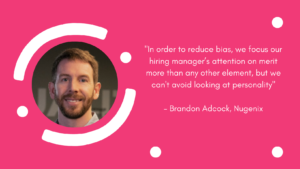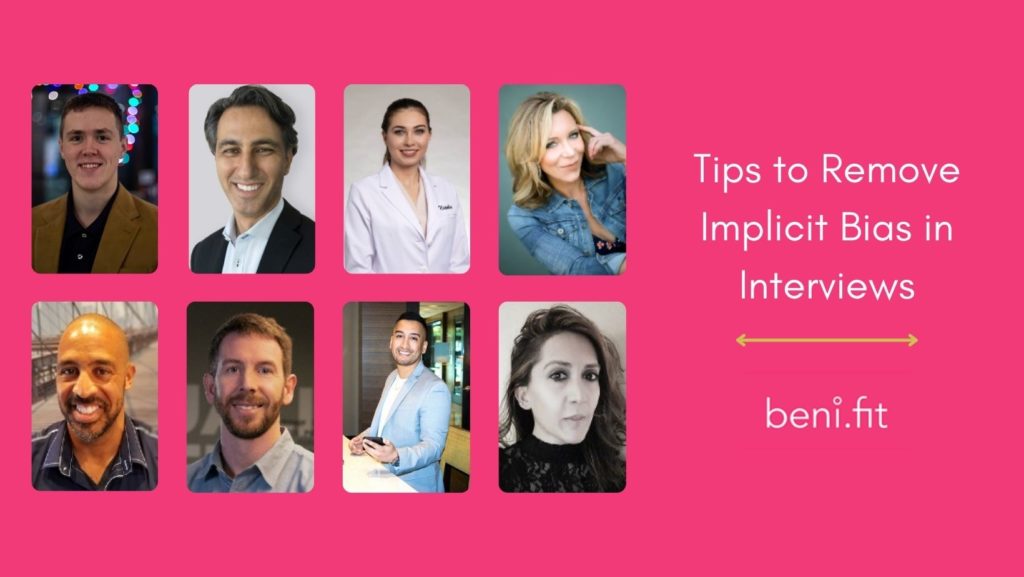What is one tip for hiring managers to remove implicit bias in candidate interviews?
To help you remove any implicit bias when interviewing candidates, we asked recruiters and HR professionals this question for their best tips. From removing applicant names to reducing the number of interviews, there are several recommendations that may help your interviews be bias-free.
Here are 10 tips for removing implicit bias from your candidate interviews:
- Remove Names to Remove Bias
- Ask Every Candidate the Same Set of Questions
- Ditch Simple Heuristics & Focus on Evidenced Merit
- Making Hiring a Collective Effort
- Structure the Interviews
- Write an Inclusive Job Description
- Focus on the Present Moment
- Be Transparent About Present Biases
- Keep the Interview Slow & Steady
- Reduce the Number of Interviews
Remove Names to Remove Bias
Perform blind application reviews or skills tests for the candidates. By removing names from the process, you’ll have greater focus on applicants’ qualifications with less risk of implicit biases seeping through. Skills challenges are especially handy as they help you to assess the quality of a prospective hire’s work without focusing on external characteristics, such as their age, name, etc.
While blind assessments should be just one part of a broader strategy to remove unconscious bias, putting more emphasis on a candidate’s skills can help narrow the gap that these biases create and allow you to hire the brightest and most talented applicants.
Lisa Odenweller, Kroma Wellness
Ask Every Candidate the Same Set of Questions
Objectivity is the best antidote for bias. Standardized interviewer scripts can help you more objectively compare candidates after the fact since you’ll have their responses to the same set of questions. If you just have a suggested list of questions, with no clear guidelines about which or how many to ask, this allows interviewer bias to influence the process.
For example, they may ask a female candidate about her family/home responsibilities but not ask that question of male candidates, or may make other assumption-based decisions about what information they gather during interviews. This can lead to companies inadvertently making biased hiring decisions, because those decisions are based on a flawed data set.
Archie Payne, Caltek Staffing
Ditch Simple Heuristics & Focus on Evidenced Merit
In order to avoid bias, hiring managers have to limit their dependence on simple heuristics and focus on merit. Nonverbal attributes such as voice, height, weight, or even gait can significantly influence how an interviewer perceives a candidate, even though the candidate is not necessarily in control of any of them. In order to reduce bias, we focus our hiring manager’s attention on merit more than any other element, but we can’t avoid looking at personality.
But we leave less to the gray area and assumption by requiring interviewers to give very clear examples of how candidates exemplify desired personality traits like friendliness, honesty, and diligence.
Brandon Adcock, Nugenix

Making Hiring a Collective Effort
It’s not unusual for companies to leave the entire hiring process to one individual from writing the job description to marketing, recruiting, and onboarding. Even with the most well-meaning hiring manager, without checks and balances, implicit bias will flourish.
Hiring managers can work around this by building a cross-functional team to make hiring a collective and representative effort. This way, a candidate will get the opportunity to be interviewed by people from different backgrounds. Recruitment influenced by a cross-functional logic ensures that other interviewers can identify biases in others and provide checks and balances for the hiring manager. Thereafter, any conversations about the candidate are more likely to be objective with little interference from unconscious bias.
Joe Coletta, 180 Engineering
Structure the Interviews
Some experts suggest that hiring managers use structured interviews in order to reduce the impact of implicit bias. This means that all candidates are asked the same questions in the same order, and their responses are rated using objective criteria. Additionally, it may be helpful for hiring managers to consult with a diverse group of people when making decisions about which candidates to interview and hire. By doing so, they can ensure that a variety of perspectives are taken into consideration and that implicit biases are less likely to sway the final decision.
Brian Meiggs, My Millennial Guide
Write an Inclusive Job Description
The best way to attract and recruit diverse candidates is by writing an inclusive job description. Leading with gender-neutral language attracts candidates from all walks of life, despite their age, race, gender, or background. For example, instead of using pronouns to describe a specific role, consider using “you”. When inclusive language is used, it gives more opportunity for candidates with new ideas and opinions instead of language that is off-putting or biased.
Natália Sadowski, Nourishing Biologicals

Focus on the Present Moment
Hiring managers need to remember the objective of their role and why they are interviewing candidates for specific positions. There are hiring managers who bring their implicit bias derived from past (personal & professional) experiences and perhaps insecurities that get projected unfairly upon candidates interviewing for the role. They need to focus on the present moment.
If hiring managers encountered complications in their past hiring activities, it’s wise to extract the lessons learned to avoid similar future mishaps. It’s wrong to assume the past outcomes will repeat themselves unless the hiring manager is not fit to perform their job because their personal biases are tainting the candidate interviewing process. I’ve seen hiring managers personally project their implicit bias upon candidates when their job is to remain neutral when learning about these candidates. Stay in the moment, make eye contact and have a human conversation. Be professional, pay attention and don’t make it about you.
Sasha Laghonh, Sasha Talks
Be Transparent About Present Biases
Every human has biases, so create a culture where admitting bias is encouraged and accepted. As a recruiter, I’ve asked hiring teams to put any biases in their scorecard. They might be things like “I went to the same college as this candidate” or “I had a past experience hiring from this company in the past and it wasn’t positive”. By calling out biases, the recruiter and hiring manager can build checkpoints into the decision process to make sure those biases aren’t eliminating great talent, or bringing the wrong talent into your organization.
Steph McDonald, HubSpot
Keep the Interview Slow & Steady
When people feel rushed or stressed, they rely on implicit bias to help them make fast decisions. If you slow down the thinking/decision process, you’ll inherently be less biased. So how does a hiring manager slow down? The answer is equally beneficial. Hiring managers should focus on automating as much subjective questioning that can be done in the hiring process. This will give them more time and less stress to move candidates along the hiring pipeline.
Kelly Skelton, Backyard Assist
Reduce the Number of Interviews
The number of interviews candidates need to go through has been growing over the years. I’ve seen up to 16 rounds of interviews. And many organizations have developed a consensus-oriented culture, where if one interviewer objects to the candidate, they tend to turn down this person.
Each interviewer will have some implicit bias, even if they try to reduce this. And the more interviewers you have, the higher the likelihood that one of these interviewers will object to a candidate due to an implicit bias. The better approach, therefore, is to cap the number of interviewers at four to five people.
Atta Tarki, ECA Partners
Terkel creates community-driven content featuring expert insights. Sign up at terkel.io to answer questions and get published.


